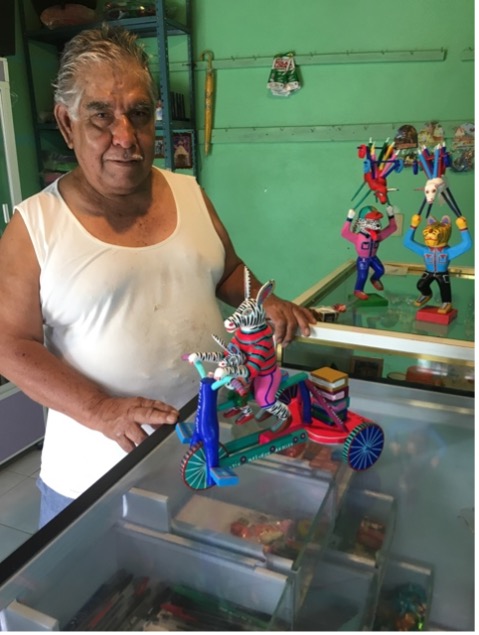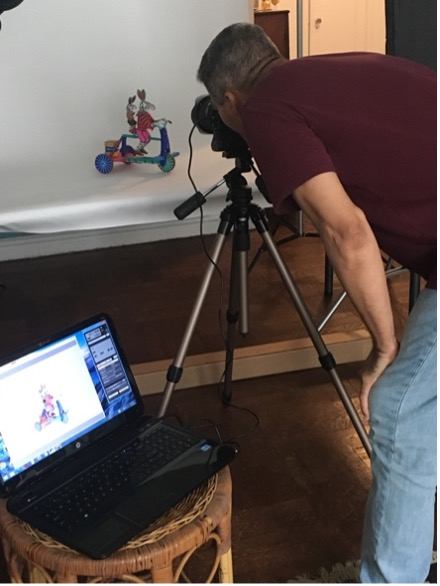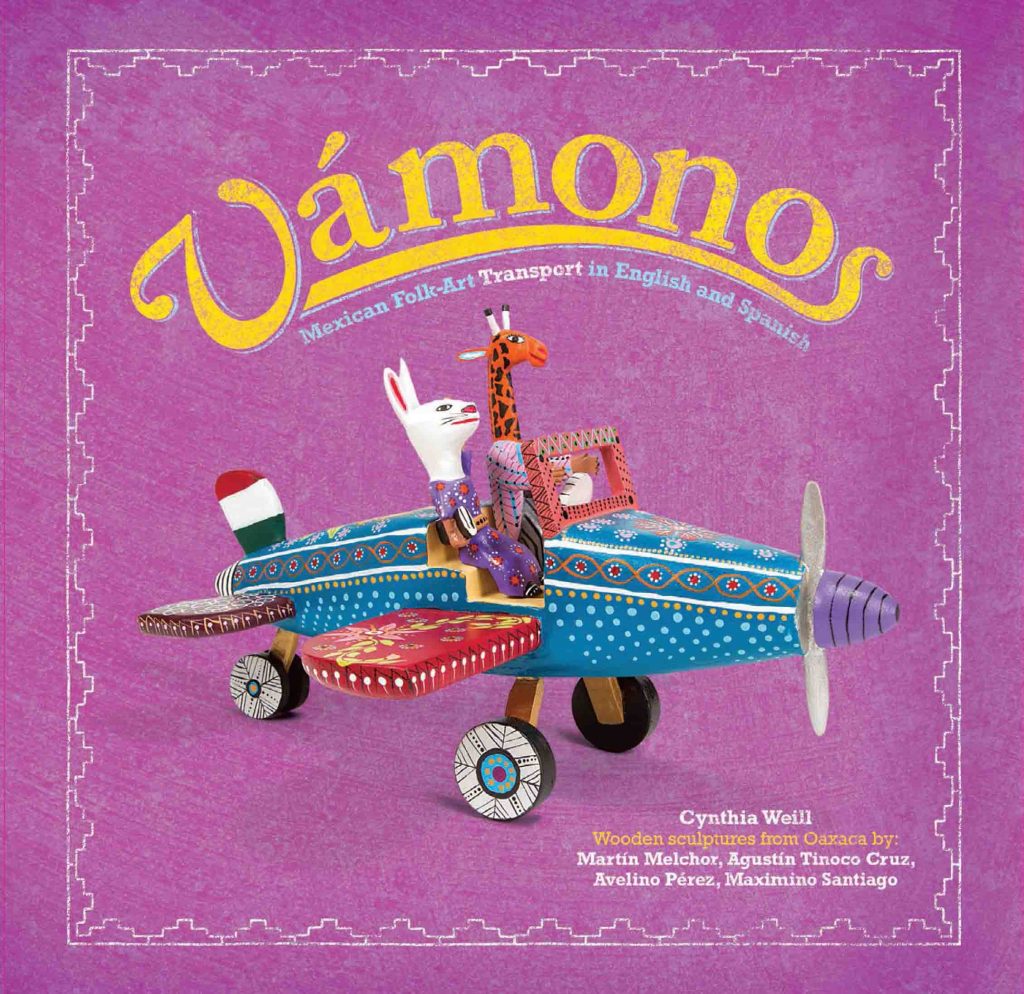In this guest post, author Cynthia Weill shares the joyous process of collaborating with craftspeople from Oaxaca and the relationships that grew along the way. Vámonos, illustrated with art by Augustín Tinoco Cruz, Martín Melchor, Maximino Santiago, and Avelino Pérez, is available wherever books are sold.
I’m still amazed that Vámonos is my eighth book in the Mexican Folk Art series. I would never have believed when starting back in 2003 that twenty years later, I would still be making books with Oaxacan artisans.
Development of every single work has been an incredible adventure. I’ve loved every minute of collaborating with and learning so much from the wonderful craftspeople of one of Mexico’s most artistically rich states.

ABeCedarios started with the help of the Jiménez family of Arrazola, Mexico. (Watch the video for more information about the family and their process of working.) When we began the relationship, I told master wood carvers Armando and Moíses that they would be sculpting animal wood carvings that would represent each letter of the alphabet. Creating all of the pieces for the book took place over four summers. As we worked, I was often bewildered by the varying dimensions of each piece made. Some were small. Some were gigantic. I kept reminding the artisans that proportions had to be the same, but it never quite worked out that way. My co-author and the photographer of the book, K. B. Basseches, had to do quite a bit of manipulation in PhotoShop to give the final text a sense of uniformity.

Nonetheless when the book was finally published each family received copies. One of the artisans laughed and said, “I had no idea what we were doing, I thought that you were writing a book about us.” I realized later that Oaxaca is a rich site for anthropologists who are forever interviewing the artisans for books about them. I also realized that rural artisans had few children’s books around. These families were accustomed to sharing stories through the oral tradition. The artisans had never seen a children’s alphabet book before.

As work on each new book commenced, I continued to sit with the artisans on a daily basis in often remote, mountainous locations while they hand carved each piece. For me this meant multiple trips to Oaxaca and long hours on rickety buses, often down dirt roads. These relationships and experiences, however, brought so much joy and multiple invitations to quinceañeras, baptisms, weddings, and local cultural events. Each experience taught me more about the everyday realities of rural artisans, their perspective, and cross-cultural collaboration.

When I thought about doing a book on transportation in 2019, which eventually became Vámonos, I had been away from Oaxaca for a couple of years. In that time, internet technology had changed so many aspects of Mexican life. Prior to leaving for Oaxaca, WhatsApp made it possible to make multiple free, long-distance phone calls and to send pictures and drawings back and forth. Imagine my relief when, while lost in the mountains and searching for Maximino Santiago, I was able to reach him via cell phone and he located me in a ravine about a quarter mile from his home. In previous trips, I would have ended up searching all day. In the end, instead of needing to be present during multiple trips months at a time, I was able to get all the pieces for the book in one journey.
As happy and productive as this experience had been, my return to Oaxaca in December 2021 was sad. Having a few days of unused vacation, I made a quick trip to Oaxaca to show the artisans an early version of Vámonos. I have always marveled at the resilience of my artisan friends and was so saddened by how the pandemic had affected them. Most had faced a bout of pre-vaccine Covid with no access to quality medical care. All had lost at least one family member. With the lack of tourism, they had had no way to earn a cash income. All had been shaken to the core by the experience, and it showed in their demeanor. One of the artisans told me, “If it hadn’t been for a vegetable garden and a couple of chickens, I could not have fed my kids.”
Showing the artisans the photocopies of the book-to-be did inject a small bit of joy into everyone’s winter. Luckily, a year later, life is slowly returning to normal, and visitors and clients are returning. I know the artisans are looking forward to receiving the travelers who will seek them out once Vámonos becomes widely available.

Again, through the marvels of technology, I have been able to share the first copy of Vámonos with the artisans. (Friends will bring down artisan copies later in the year.) Upon seeing his plane on the cover, Agustín Cruz said, “This makes me feel like I can keep on going.” Martin Melchor, creator of the animal figures on bikes, shared that “this book helps keep our culture alive.” And Avelino Perez, the maker of the bus on the back cover, said, “I love the work I do, and I love having my work shown in a book for children.”
Later this year, the pieces from the book will join the work from all the other books in the series and become part of the permanent Meso-American Collection at the Field Museum of Chicago. The curator will write a letter acknowledging the artisans, which they will be able to hang in their workshops. Maximino Santiago, maker of the horse carts and boat, said, “I am so happy and proud,” and laughingly added, “I feel so important!”
For more information about how the work is made go to cynthiaweill.net.
Praise for Vámonos:
★”This is one extraordinary picture-book journey to the library . . . Gorgeous, unique art makes this an illustrative standout.” —Kirkus Reviews
Watch a read-aloud and learn more about the art-making process for Opuestos, another title in the Mexican Folk Art Series.
Cynthia Weill holds a doctorate in education from Teachers College Columbia University. She has worked as an educator and in the field of international development. She has been fascinated with Oaxacan crafts since 1996 when she taught in Mexico through the Fulbright exchange. She is on the advisory board of the Friends of Oaxacan Folk Art Foundation whose mission is to promote and preserve the artists and artisanal work of the state. She has published eight books that feature the folk art of Oaxaca.










